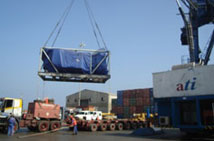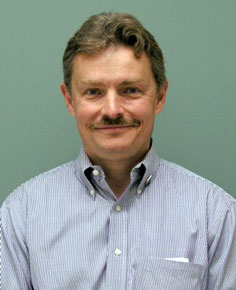NRAO eNews: August 2008 • Volume 1, Issue 3

First Prize, 2007 AUI/NRAO Image Contest: Birth and Death in the Milky Way. A VLA-Spitzer panorama of the Milky Way in Scutum and Aquila. Image by Rick White (STScI), Bob Becker (IGPP/LLNL & UC-Davis), and David Helfand (Columbia)
The AUI/NRAO Image Contest deadline is Wednesday, 3 September 2008. First Prize: $1,000. Second Prize: $500. Third Prize: $250. Honorable Mentions: $100 each. We look forward to seeing your images!
Contest Info | Submit Images
ALMA Construction
Al Wootten
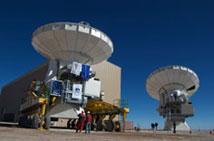
The transporter sets Vertex antenna No 2 down beside No 1 after moving it from the Assembly Building on 8 July in Chile.
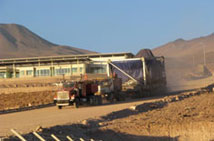
The pedestal for Vertex antenna no 6 arrives at the Site Erection Facility at the Operations Support Facility (OSF) on 31 July.
With the successful move of Vertex antenna No 2 by the Atacama Large Millimeter/submillimeter Array (ALMA) transporter from the Assembly Building to an antenna station near Vertex antenna No 1 (top left), one station became available in the building. The pedestal for Vertex antenna No 6 arrived to occupy that station on 31 July, creating a full house at the Site Erection Facility in Chile. Testing of Vertex antenna No 1 was therefore a focus of activity during July. A team led by Darrel Emerson conducted holography measurements and were able to beat residual errors for the surface to below 12 microns by the end of the month. After acceptance of an antenna by ALMA, the transporter will move it to a station outside the ALMA Operations Support Facility for further tests. A second holography tower is now ready for the tests that are planned there.
CASA Update
CASA Team
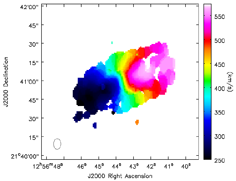
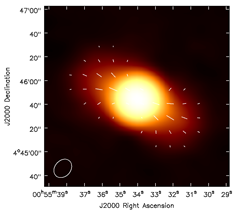
These images were created during the CASA tutorials at the June NRAO Synthesis Imaging Workshop. Top: CO(1-0) kinematics (moment 1) of the galaxy NGC4826 from the BIMA SONG survey (see Helfer, Thornley, Regan et al. 2003, ApJS, 145, 259). Bottom: Archival VLA 6 cm continuum and polarization image of Jupiter. View scripts and data.
The Common Astronomy Software Applications (CASA) package being developed by NRAO and ALMA will be used for offline reduction and analysis of both ALMA and Expanded Very Large Array (EVLA) data. CASA is fully scriptable and offers a growing suite of data reduction tasks written in C++ with a Python interface, plotting through matplotlib, and a Qt based Viewer.
CASA is now being used regularly to reduce data from the ALMA Test Facility (ATF) in New Mexico, and is also being used to fill data from the new EVLA correlator. The CASA development team recently carried out data reduction tutorials for ~50 participants at the 11th NRAO Synthesis Imaging Workshop in June. The tutorials included data ranging from Very Large Array (VLA) HI spectral line, VLA continuum polarization, and Berkeley Illinois Maryland Association (BIMA) millimeter CO line data, and the participant feedback was very positive.
The CASA package is currently (mid-July 2008) on Patch 2 of its Beta release, and is now available to the astronomical community for download. A CASA helpdesk is also available from the same site. Please try out CASA on your own data and join us in our efforts to improve and expand its capabilities. More information on the status of CASA, how to get started, and its current capabilities can be found at the CASA website.
VLA and VLBA/VLBI Proposals and Scheduling
J. M. Wrobel and B. G. Clark, VLA/VLBA Scheduling Officers
VLA/VLBA Proposals and Scheduling:
The table shows the next two deadlines for regular and large proposals for the Very Large Array (VLA) and the Very Long Baseline Array (VLBA): October 1, 2008 and February 2, 2009.
| Array | Deadline | Observing Period | Configuration |
| VLA | 2008 Oct 1 | 2009 Jan 12 - Jan 23 | Move |
| 2009 Jan 23 - Feb 9 | BnA | ||
| 2009 Feb 9 - Feb 13 | Move | ||
| 2009 Feb 13 - May 18 | B | ||
| 2009 Feb 2 | 2009 May 18 - May 29 | Move | |
| 2009 May 29 - Jun 15 | CnB | ||
| 2009 Jun 15 - Jun 19 | Move | ||
| 2009 Jun 19 - Sep 14 | C | ||
| VLBA | 2008 Oct 1 | 2009 mid Jan - mid May | |
| 2009 Feb 2 | 2009 mid May - mid Sep |
- VLA proposals
- VLBA proposals
- Observing proposal submission (use your 'MY.NRAO' account or create one)
- VLA and VLBA scheduling (dynamic and fixed date)
HSA Proposals and Scheduling:
The NRAO handles regular proposals for the VLBI High Sensitivity Array (HSA) at the same deadlines as for the VLBA. The HSA includes the VLBA, VLA, GBT, and Arecibo in the U.S., plus Effelsberg in Germany.
- High Sensitivity Array (HSA)
- Observing proposal submission (use your 'MY.NRAO' account or create one)
- HSA scheduling (fixed date)
Global cm VLBI Proposals and Scheduling:
The NRAO and the European VLBI Network (EVN) jointly handle proposals for observing time on the Global VLBI Network at centimeter wavelengths. The deadline is 2008 Oct 1 for the session in 2009 Feb/Mar.
- NRAO network and EVN network
- Observing proposal submission (use your 'NorthStar' account or create one)
- Scheduling is on fixed dates during global sessions
Global 3mm VLBI Proposals and Scheduling:
The NRAO and a set of European observatories jointly handle proposals for VLBI observing time at a wavelength of 3mm. The deadline is 2008 Oct 1 for the session in 2009 May.
- The Global mm-VLBI Array
- Proposal preparation (via the LaTeX template)
- Proposal submission is via e-mail to propsoc@nrao.edu and propvlbi@mpifr-bonn.mpg.de
- Scheduling is on fixed dates during global sessions
A Sister Cities Student Exchange across Hemispheres
Robyn Harrison and Mark Adams

The Chilean and U.S. students participating in the 2008 Sister Cities student exchange program between Magdalena, NM and San Pedro de Atacama (left to right): Aracelli Ramirez, Lenaya Montoya, Soiky Casanga, and Charles Chavez.
The villages of Magdalena, New Mexico in the United States, and San Pedro de Atacama in Chile’s Region II are culturally similar. The majority of their populations are of native or Spanish ancestry; they derive the bulk of their income from agriculture and tourism; they are small communities of similar population; and they are both located in high-elevation desert near major international radio astronomy research facilities. The Very Large Array is just 25 km west of Magdalena; the Atacama Large Millimeter/submillimeter Array (ALMA) is only 40 km east of San Pedro de Atacama. Both villages have a single high school serving a large geographic area.
In September 2006, Mayor Jim Wolfe and the Village Council of Magdalena officially proclaimed San Pedro de Atacama its Sister City. San Pedro de Atacama Alcaldesa Sandra Berna proclaimed the same of Magdalena in December 2006. Thus began a close relationship and a mutually beneficial educational and cultural exchange between these towns, nourished and funded by Associated Universities, Inc. (AUI) and the NRAO.
In February 2007, San Pedro Principal Myriam Rivera, tourism teacher Gabriela Rodriguez, and Alcaldesa Sandra Berna visited Magdalena and participated in numerous school and community events. Magdalena Schools teachers Jim Sauer and Sandra Montoya returned the favor by traveling to San Pedro the following July. In the current semester, August – December 2008, the NRAO is sponsoring a student exchange, enabling two students from each community to spend a semester experiencing the culture of another hemisphere, living with host families and attending school in their new homes.
When Aracelli Ramirez and Soiky Casanga stepped off the plane in Albuquerque, New Mexico in early August, the weather was considerably warmer than the winter temperatures they had left in San Pedro de Atacama, Chile, the previous day. Charles Chavez and Lenaya Montoya will find the opposite temperatures when they leave Magdalena, New Mexico, and head for San Pedro later this month.
Mike Chambers, Superintendent of Schools in Magdalena, is so excited about the program that his family is hosting Aracelli. “I don’t know of a better way to broaden these kids’ horizons,” Chambers said, referring not only to the students but to his own children as well.
All four students hope to become fluent in the language of the culture they are visiting and intend to make lasting friendships. Charles is the son of Charley and Alma Chavez. Charley is head of technical services at the Very Large Array. Lenaya Montoya is the daughter of Linda and the late Manuel Montoya, former security guard at the VLA. Chilean student Soiky is living with the family of Sandra and Tommy Montoya. Tommy is a welder at the VLA and Sandra traveled to Chile last summer.
ALMA EPO Program Officer
Fred K.Y. Lo and Mark Adams
It is our pleasure to announce that John Stoke joined the NRAO on 4 August as ALMA EPO Program Officer. John will work closely with the Director's Office, the North American ALMA Science Center, and the NRAO EPO team to create an ALMA EPO program that greatly improves the visibility and impact of ALMA in the science community and with the public.
John has an undergraduate degree in astronomy and 25 years of experience with education and public outreach. For the past nine years, John has managed the Informal Education branch of the Space Telescope Science Institute's (STScI) Office of Public Outreach and led the development of the ViewSpace network of self-updating astronomy displays that are now available in more than 180 museums, planetariums, and visitor centers, including the NRAO Edgemont Road lobby in Charlottesville. While at STScI, John also produced an award-winning IMAX short film and secured major grant funding from NASA's Earth Observing System to incorporate earth science into his ViewSpace program. Most recently, John has also been the lead for the James Webb Space Telescope EPO program.
We are delighted to welcome John to the NRAO, to ALMA, and to our EPO team.
 Zoom
Zoom